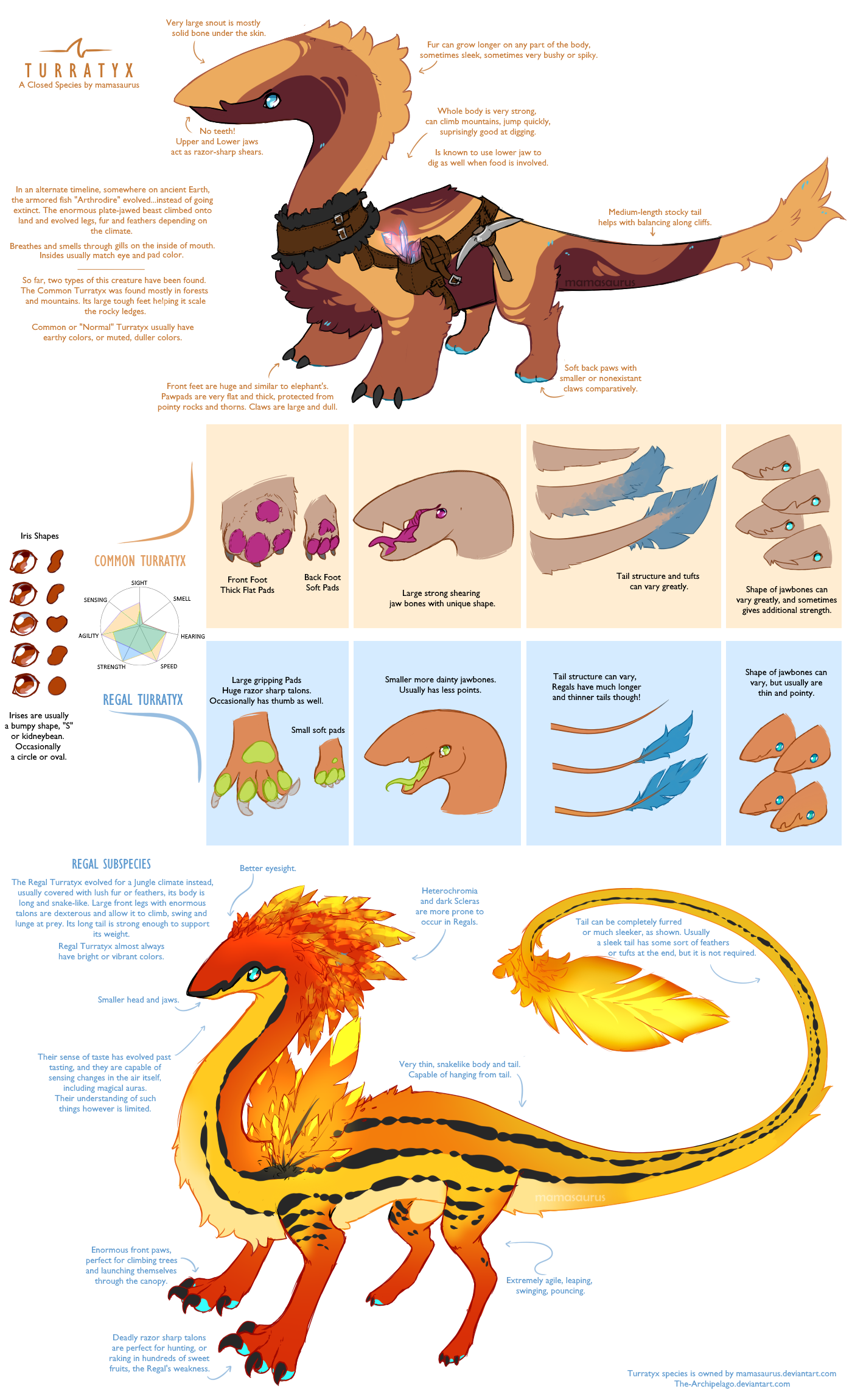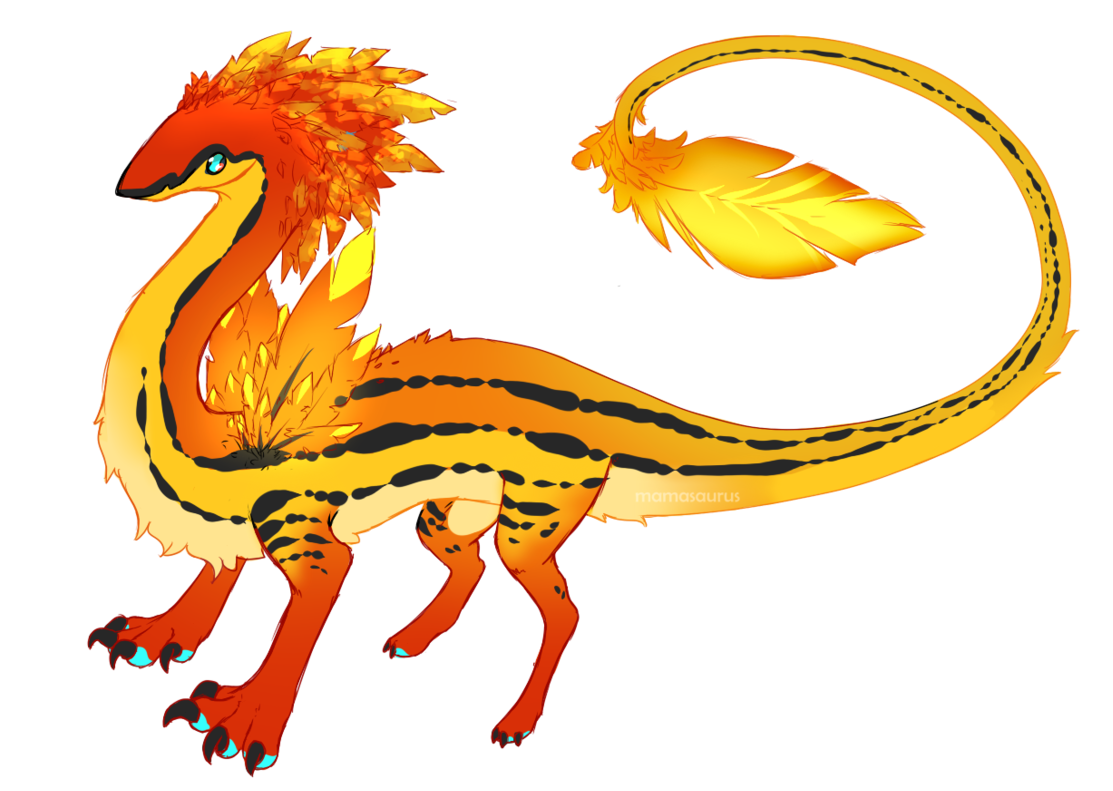The Turratyx
(tur-a-ticks)
THE PREHISTORIC SPECIES

With a mouth like a Dunkleosteus and large soft paws for climbing, the Turratyx doesn't really make much sense, but then again... does anything on the Archipelago make sense?
Turratyx are a quadrupedal dinosaur species that evolved from sharks that literally grew bored of eating fish. Over millennia they crept further and further up the shoreline, chasing bigger and more challenging prey until they found themselves as you see them now. There are two subspecies of Turratyx, one who stuck to rocky mountainous regions throughout its evolution, and the other which stayed more in the tropical forested areas. They each developed their own tastes and traits.
Turratyx insides, including their mouth, tongue and eye are all usually the same color, which can be quite bright, even for commons. Sometimes its bright enough to give off a bioluminescent glow.
Their irises are a softened lightning-jag shape, and their eyes are on their bottom jaw. Their skull shape is always similar in general, but the jagged edges of their jaw-plates vary.
Diet ranges from plants, insects and small mammals, to larger mammals. They have strong individual characteristics, some prefer to stay in herds and frolic together, others are more reserved and may spend most their time completely alone. They communicate with bird-like chirps, tweets and trills, but when threatened or angry, they will hiss, and make a clicking-snarl noise similar to a cornered raccoon.
They can learn and interact with humans but cannot speak human languages. Their intelligence level is near that of horses or dogs.
| The Common Turratyx, being the mountain version, is generally the one you will see, as the jungle ones are just a bit more rare. They have solid beak-like plate jaws, which can vary in sharpness based on the individuals diet and sharpening tactics. These jaw plates are not dead bone, they will heal if chipped for example. If it is broken off severely or damaged below the nerve endings, it might not grow back. Their bodies are quadrupedal, and covered in very soft, thick fur. Fur along the back of the neck and at the end of the tail can be much longer and more rigid, almost feather or quill-like. Their front feet have large shell-shaped central paw-pads, and three toes with large dull claws and two small balancing pads. The balancing pads are almost always hidden under the fur, and have no bone-structure. The Turratyx uses these muscles when climbing in the mountains to help grip the rock and balance.Back paws have dense thicker pads, and three small toes with elephant-like claws, and one balancing toe each. Common turratyx usually have muted or soft/natural colors. |  |
 | In stark contrast to the common, the Regal Turratyx is a brightly colored lithe creature of the trees. Calling the tropical rain-forests and jungles home, they thrived for eons, adapting to the very vertical world they'd claimed. Their beak-like jaws became smaller and sharper, and their bodies thinned to be able to slink and weave through the trees. Balance pads were unneeded in the trees, and they lost them in favor of large grasping talons with thick soft pawpads, capable of climbing or grabbing prey. Their stiff furred areas elongated further, and even looks like feathers in some cases. They are very excitable and loud, and can mimic human languages like parrots do. |
As the age of dinosaurs began to unfold on earth, the kindhearted Turratyx found themselves being slowly taken out by the larger more powerful creatures. This is when the Khle'ahd happened upon them and invited the strange evolutionary anomaly to join them on the Archipelago. The Turratyx could not speak, but were sensed as being ready to move on from their home, wanting to survive while allowing future species to develop there. They now reside in the mountains near the Shimm on the Archipelago's Northwestern-most continent.
Species History
Original Concept created on July 1, 2014
Original Species Sheet posted on September 29, 2015
Current Species Sheet Posted on April 21, 2018
First Character of the Species was Bjorn
Moved to toyhouse 'world' July 2018
Moved to wix world site Feb 2019
Moved to TH world here Feb 2020